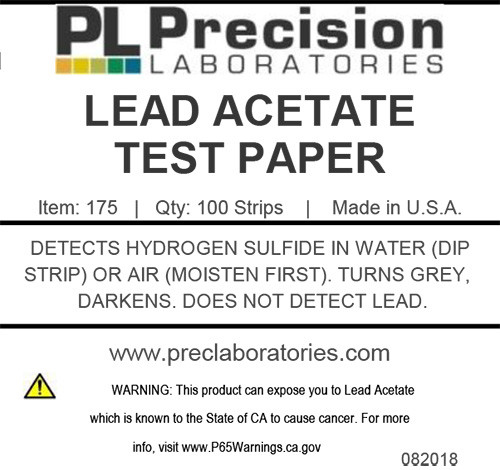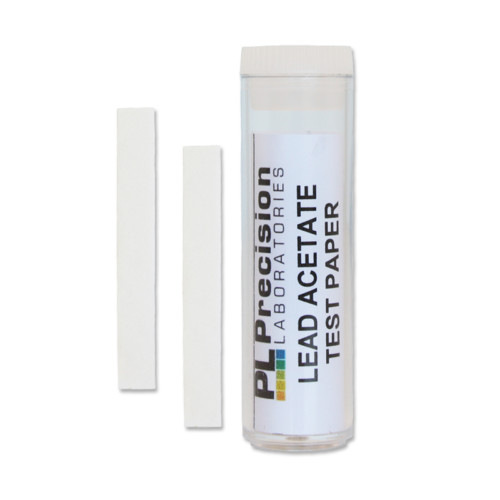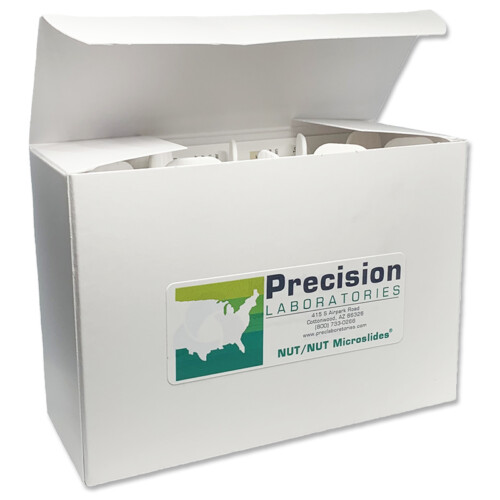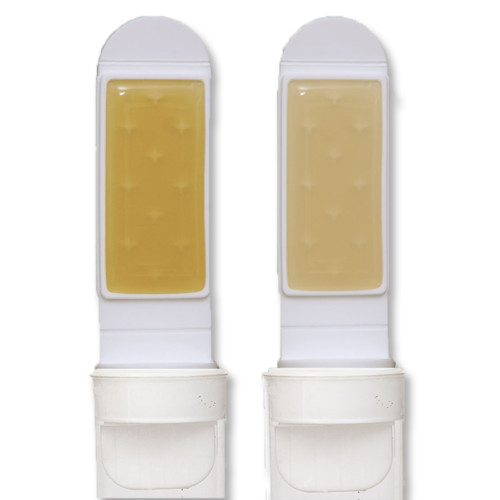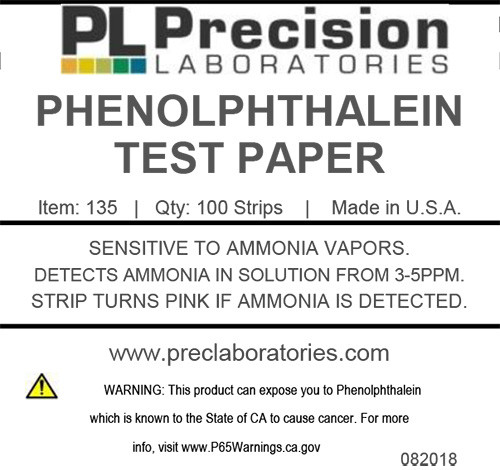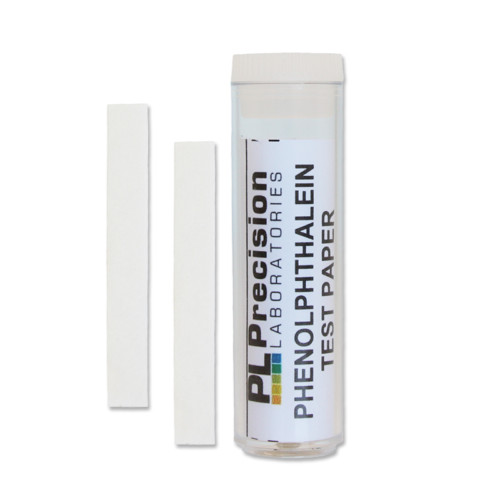-
 Chlorophenol Red (CPR) test paper is useful in differentiating between a solution with an acidic pH and one with a more neutral pH. The unreacted paper is yellow/orange in color. At neutral pH (about 6.7) the paper will turn a reddish color. At higher pH values, the paper will turn more violet. Given that the paper starts out yellow/orange and turns red at roughly the pH of water, it is useful in finding water leaks.
Chlorophenol Red (CPR) test paper is useful in differentiating between a solution with an acidic pH and one with a more neutral pH. The unreacted paper is yellow/orange in color. At neutral pH (about 6.7) the paper will turn a reddish color. At higher pH values, the paper will turn more violet. Given that the paper starts out yellow/orange and turns red at roughly the pH of water, it is useful in finding water leaks. -
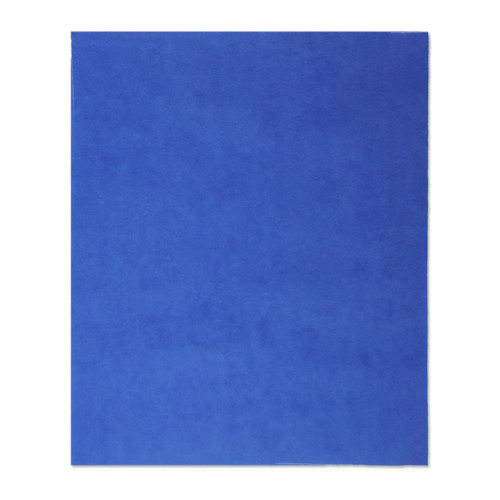 Bromophenol Blue (BPB) test paper is useful in differentiating between a solution with an acidic pH and one with a more neutral pH. At pH 3.0 and lower, the paper will be a yellow/green color. Above pH 4.6, the paper will remain blue (it is blue when unreacted). This paper can be used to monitor acid washes (yellow/green) and subsequent rinse waters (blue). This paper can also be used to monitor a pickling process where the pH (acetic acid or vinegar) of the solution must be below 4.6.
Bromophenol Blue (BPB) test paper is useful in differentiating between a solution with an acidic pH and one with a more neutral pH. At pH 3.0 and lower, the paper will be a yellow/green color. Above pH 4.6, the paper will remain blue (it is blue when unreacted). This paper can be used to monitor acid washes (yellow/green) and subsequent rinse waters (blue). This paper can also be used to monitor a pickling process where the pH (acetic acid or vinegar) of the solution must be below 4.6. -
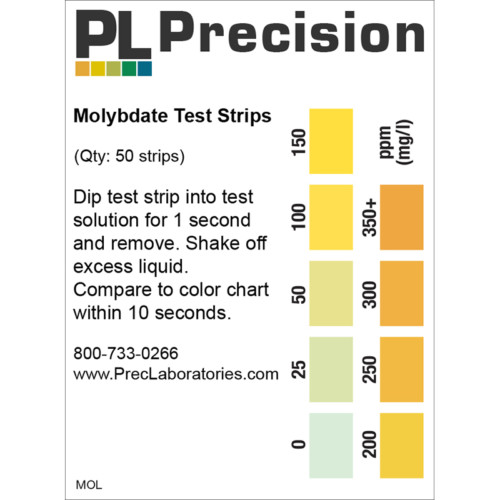
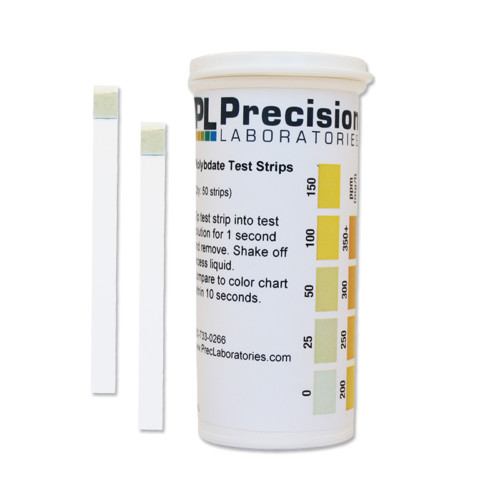 The Molybdate test strip detects molybdate (MoO4-2) levels from 0-350ppm in increments of 0-25-50-100-150-200-250-300-350ppm. Molybdate is commonly used as a corrosion inhibitor in the water treatment industry. Molybdate is effective in chilled or hot water systems over a wide pH range and is not normally affected by the use of biocides, such as chlorine. When used alone, molybdate levels of 300 ppm or more are needed to effectively inhibit corrosion. This can be expensive, and therefore most molybdate-based inhibitors include other ingredients that enhance the overall inhibition properties and reduce the amount of molybdate needed. This test strip can provide an economical means to monitor ppm levels. Consult with the manufacturer of the treatment chemical being used for details on the concentration of molybdate to be maintained.
The Molybdate test strip detects molybdate (MoO4-2) levels from 0-350ppm in increments of 0-25-50-100-150-200-250-300-350ppm. Molybdate is commonly used as a corrosion inhibitor in the water treatment industry. Molybdate is effective in chilled or hot water systems over a wide pH range and is not normally affected by the use of biocides, such as chlorine. When used alone, molybdate levels of 300 ppm or more are needed to effectively inhibit corrosion. This can be expensive, and therefore most molybdate-based inhibitors include other ingredients that enhance the overall inhibition properties and reduce the amount of molybdate needed. This test strip can provide an economical means to monitor ppm levels. Consult with the manufacturer of the treatment chemical being used for details on the concentration of molybdate to be maintained. -
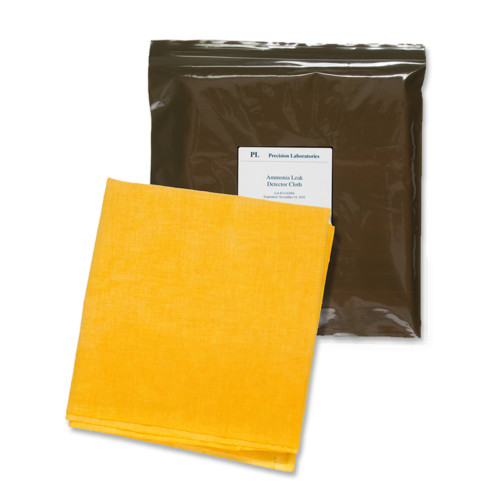 The Ammonia Leak Detection Cloth is used for the detection of leaks in sealed incubators, such as those used for infectious disease studies and in the treatment of premature birth. Industrial uses for detection of ammonia gas include sealed containers and filtration systems. The cloth is sensitive to vapors from a 1% solution of Ammonia. The Ammonia Leak Detection Cloth is reversible. As long as the cloth reverts back to the original goldenrod yellow color, it will continue to change when exposed to ammonia vapors. However, we aren’t certain of how many times it can be reused (it is somewhat dependent on the use). Eventually, it will not revert back to its original color and can no longer be reused. It works best if exposed to vapors. If the cloth gets wet, it will not be reusable.
The Ammonia Leak Detection Cloth is used for the detection of leaks in sealed incubators, such as those used for infectious disease studies and in the treatment of premature birth. Industrial uses for detection of ammonia gas include sealed containers and filtration systems. The cloth is sensitive to vapors from a 1% solution of Ammonia. The Ammonia Leak Detection Cloth is reversible. As long as the cloth reverts back to the original goldenrod yellow color, it will continue to change when exposed to ammonia vapors. However, we aren’t certain of how many times it can be reused (it is somewhat dependent on the use). Eventually, it will not revert back to its original color and can no longer be reused. It works best if exposed to vapors. If the cloth gets wet, it will not be reusable. -
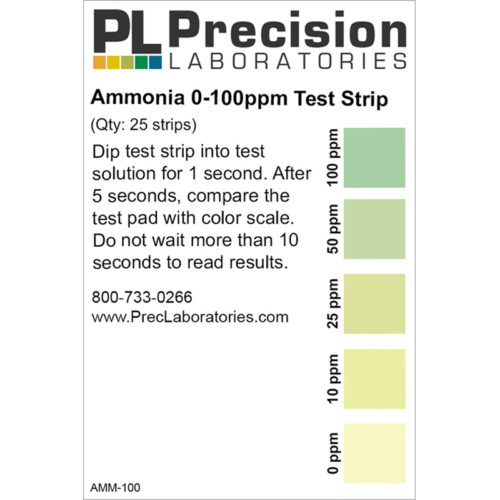
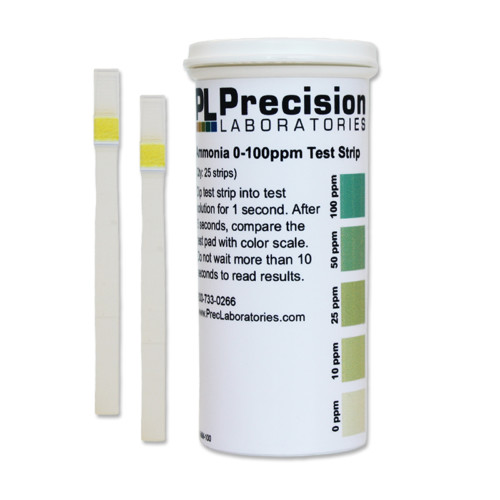 This test strip detects ammonia in increments of 0, 10, 25, 50, and 100ppm. The Low Level Ammonia test strip is designed to work for the detection of ammonia (NH3/NH4+) in water. The strip is composed of two filter pads. The first filter pad acts as an absorbent and takes up the water sample. The first pad has been treated with alkaline materials. This alkaline environment converts any ammonia to the gaseous state. The second filter pad is an hydrophobic material that has been treated in such a manner that only the gaseous ammonia is absorbed by the second filter pad. The second filter pad contains an indicator(s) capable of detecting the gaseous ammonia through a change in the pH of the filter pad.
This test strip detects ammonia in increments of 0, 10, 25, 50, and 100ppm. The Low Level Ammonia test strip is designed to work for the detection of ammonia (NH3/NH4+) in water. The strip is composed of two filter pads. The first filter pad acts as an absorbent and takes up the water sample. The first pad has been treated with alkaline materials. This alkaline environment converts any ammonia to the gaseous state. The second filter pad is an hydrophobic material that has been treated in such a manner that only the gaseous ammonia is absorbed by the second filter pad. The second filter pad contains an indicator(s) capable of detecting the gaseous ammonia through a change in the pH of the filter pad. -
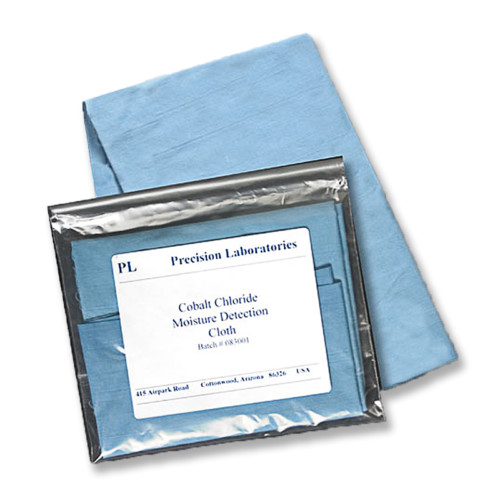 Our Cobalt Chloride cloth detects the presence of moisture to determine if you have wetness or dampness problems. The Cobalt Chloride Cloth can be cut into smaller pieces or draped over equipment. It is a fast and easy way to identify leaks in larger spaces, such as roofs, between walls, inside car doors or under ceramic tiles. The larger cloth allows for identification of spray or leak patterns when left in enclosed spaces. The Cobalt chloride cloth is responsive to 50% relative humidity and above, and any direct measure of an aqueous solution.
Our Cobalt Chloride cloth detects the presence of moisture to determine if you have wetness or dampness problems. The Cobalt Chloride Cloth can be cut into smaller pieces or draped over equipment. It is a fast and easy way to identify leaks in larger spaces, such as roofs, between walls, inside car doors or under ceramic tiles. The larger cloth allows for identification of spray or leak patterns when left in enclosed spaces. The Cobalt chloride cloth is responsive to 50% relative humidity and above, and any direct measure of an aqueous solution. -
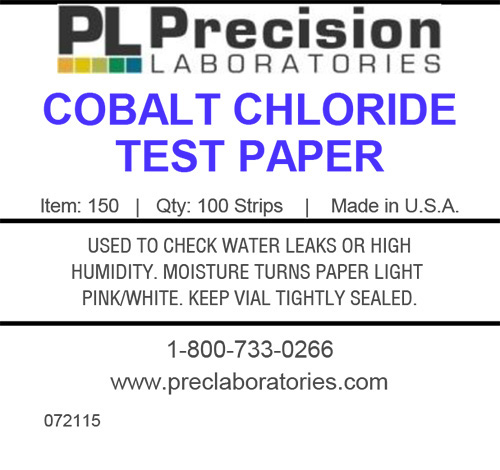
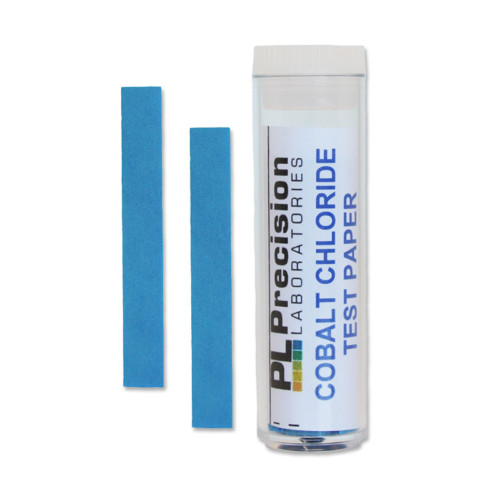 Our Cobalt Chloride test paper detects the presence of moisture. This test paper is useful in difficult to reach places and recesses. Cobalt chloride test paper is responsive to 50% relative humidity and above, and any direct measure of an aqueous solution. Cobalt Chloride test paper is also available in 8” x 10” (200x250mm) sheets (or larger sizes if special-ordered). Larger sheets allow for identification of spray or leak patterns when left in enclosed spaces. Please call for details on special orders as minimum quantities do apply.
Our Cobalt Chloride test paper detects the presence of moisture. This test paper is useful in difficult to reach places and recesses. Cobalt chloride test paper is responsive to 50% relative humidity and above, and any direct measure of an aqueous solution. Cobalt Chloride test paper is also available in 8” x 10” (200x250mm) sheets (or larger sizes if special-ordered). Larger sheets allow for identification of spray or leak patterns when left in enclosed spaces. Please call for details on special orders as minimum quantities do apply. -
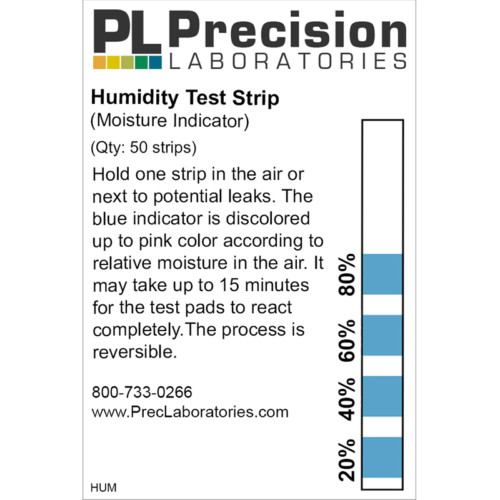
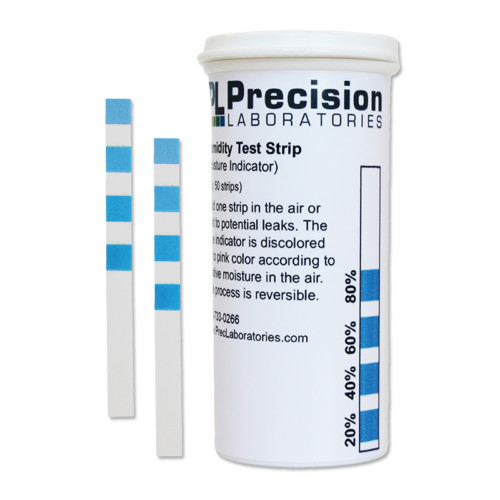 The Humidity test strip contains 4 test pads with a blue indicator, which is discolored to a pinkish color according to relative moisture in the air. The process is reversible (i.e. the pads revert back to their original blue color). The test strip responds to the relative atmospheric humidity in the range of 20% - 80%, in the steps of 20 – 40 – 60 – 80%.
The Humidity test strip contains 4 test pads with a blue indicator, which is discolored to a pinkish color according to relative moisture in the air. The process is reversible (i.e. the pads revert back to their original blue color). The test strip responds to the relative atmospheric humidity in the range of 20% - 80%, in the steps of 20 – 40 – 60 – 80%.


